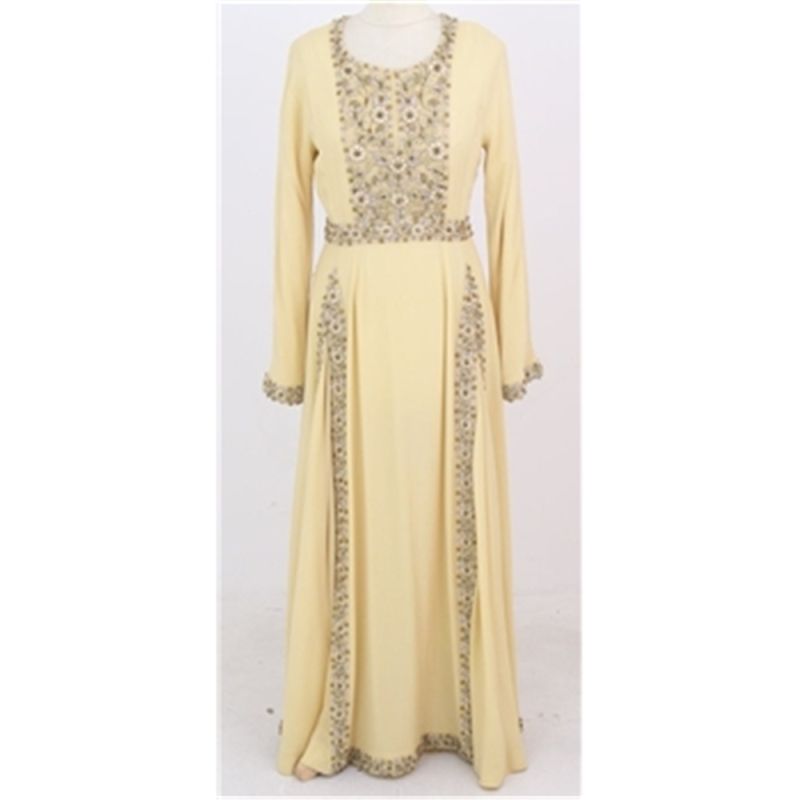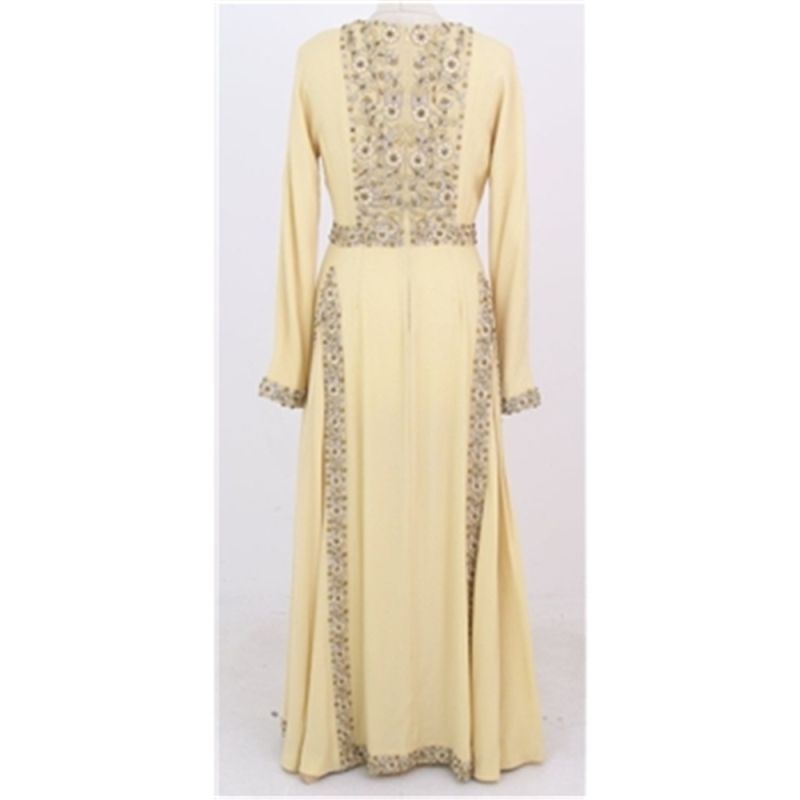Navigation
Install the app
How to install the app on iOS
Follow along with the video below to see how to install our site as a web app on your home screen.
Note: This feature may not be available in some browsers.
More options
You are using an out of date browser. It may not display this or other websites correctly.
You should upgrade or use an alternative browser.
You should upgrade or use an alternative browser.
'H & G' couture quality handmade dress- pictures added
- Thread starter Pinkcoke
- Start date
Pinkcoke
Alumni
Update, I now believe this to be a couture garment - I think it would qualify as a Tudor style gown, made from a very lightweight biscuit crepe. Full length with long sleeves, square neckline, long invisible zip of the (relatively) modern type, full skirt with at least 4 godets embellished up/down the edge of these and around the cuffs with many metres of wide metallic embroidered trim that appears to be hand sewn with a variety of beads and embellishments including crystal. The bodice front and rear princess panels also feature the same decoration all over. The dress has full french seams throughout, hand finished lining and the trim backing is also hand sewn into place. I will try and get somebody to photograph this for me today as I need to model it due to the long sleeves.
The initials are embroidered with a thicker thread within a rectangular border near the neck. The similar level of quality makes me believe this was done when the garment was made rather than added later.
Any ideas on how to find out who made this would be greatly appreciated. I have no idea where to start!
The initials are embroidered with a thicker thread within a rectangular border near the neck. The similar level of quality makes me believe this was done when the garment was made rather than added later.
Any ideas on how to find out who made this would be greatly appreciated. I have no idea where to start!

Circa Vintage Clothing
Alumni
Melanie, pics will help a great deal - even if you just post the monogramme/label it's something to go on. Any other labels?
Circa Vintage Clothing
Alumni
Are you sure it's not a costume? Also: when were invisible zippers first used in the UK? I know that we didn't get them in Australia until the '90s and I didn't see any when I worked in the London fashion industry in '91-93.
Pinkcoke
Alumni
Some pics added. No other labels I'm afraid, not even material content despite the fact I think this postdates those laws...I wanted to ask about that too as the David Campbell couture dress I posted recently also does not have material content labels - are they not required to do this when making a custom garment?
crossposting here :D
Its far too good quality for a costume - I know those pictures don't show that. But the weight of the decoration, and fabric, and the way the lining is stitched - it's just the same as the David Campbell dress I had - you can't tell where the seamstress finished putting the dress together as all the seams have been finished from the inside, including the hem and lining together, and turned inside out and then handstitched at the zip I presume. I have to read Claire's book, which I have, to get the terms for all of these techniques. I'm sure they'll be in there.
I've had invisible metal zips from the 40's, and nylon from 50's/60's so they were used at the same time as regular zips.
crossposting here :D
Its far too good quality for a costume - I know those pictures don't show that. But the weight of the decoration, and fabric, and the way the lining is stitched - it's just the same as the David Campbell dress I had - you can't tell where the seamstress finished putting the dress together as all the seams have been finished from the inside, including the hem and lining together, and turned inside out and then handstitched at the zip I presume. I have to read Claire's book, which I have, to get the terms for all of these techniques. I'm sure they'll be in there.
I've had invisible metal zips from the 40's, and nylon from 50's/60's so they were used at the same time as regular zips.
Circa Vintage Clothing
Alumni
Thank you for the info about invisible zips.
It's a misnomer to consider costumes to be poorly made - although they're more about the outside impact than the inside neatness, they have to be incredibly durable to last for the length of the production and many washes. The techniques I learnt as a costumier are superior to those I saw when working in the fashion industry, and even in my restorations, I frequently improve the quality of the finish of vintage and antique garments.
Now that I can see the pics though I agree that this is unlikely to be a costume. It may have been constructed by a professional dressmaker, many of whom still neglect to include fabric content and care labels. Heck, despite it being law many manufacturers fail in this regard. I know a local couturier who refrains from sewing any labels - apart from her own of course - in her fashions.
I look forward to seeing pics of the monogrammed label when you have them.
It's a misnomer to consider costumes to be poorly made - although they're more about the outside impact than the inside neatness, they have to be incredibly durable to last for the length of the production and many washes. The techniques I learnt as a costumier are superior to those I saw when working in the fashion industry, and even in my restorations, I frequently improve the quality of the finish of vintage and antique garments.
Now that I can see the pics though I agree that this is unlikely to be a costume. It may have been constructed by a professional dressmaker, many of whom still neglect to include fabric content and care labels. Heck, despite it being law many manufacturers fail in this regard. I know a local couturier who refrains from sewing any labels - apart from her own of course - in her fashions.
I look forward to seeing pics of the monogrammed label when you have them.
MyVintageCocktail
VFG Member
Melanie, that is lovely (can't wait to see pics of you modeling it!) and your description certainly sounds as if it is extremely well made and professionally made, with some couture techniques. I kind of doubt it is true couture, as I imagine it would have a couturier's "known" label in it, or at least a cloth label stitched into it. The monogram may be that of the professional dressmaker who fashioned it, or of the person for whom it was made. High-end custom tailored or custom-ordered garments sometimes had their owners' names embroidered into them.
Pinkcoke
Alumni
Eugh, nobody around to take pictures of me wearing it so I have taken these for now, the model is too big busted for it really, there is no gap in the back decoration near the zip when I put it on:
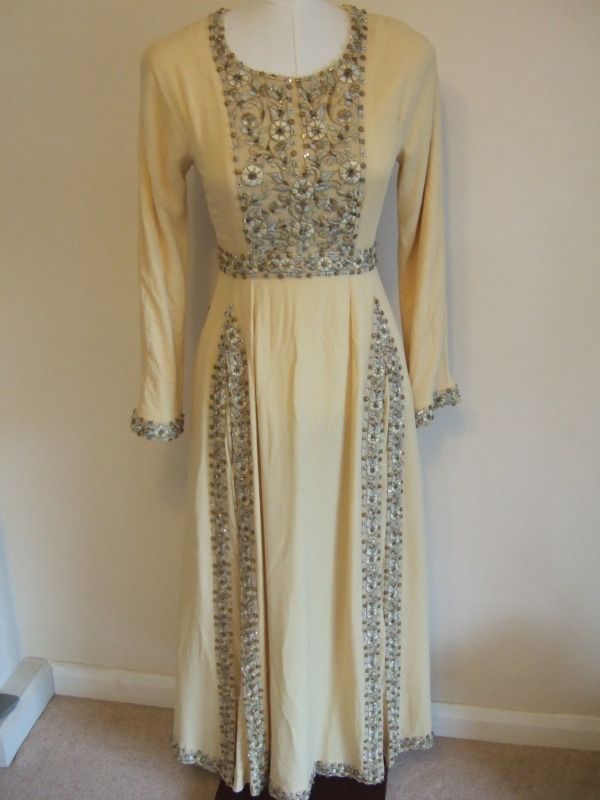
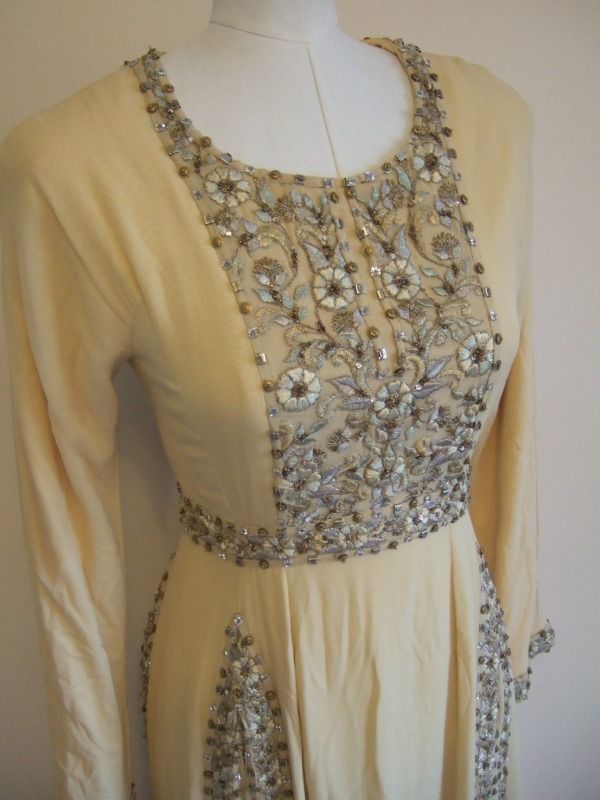
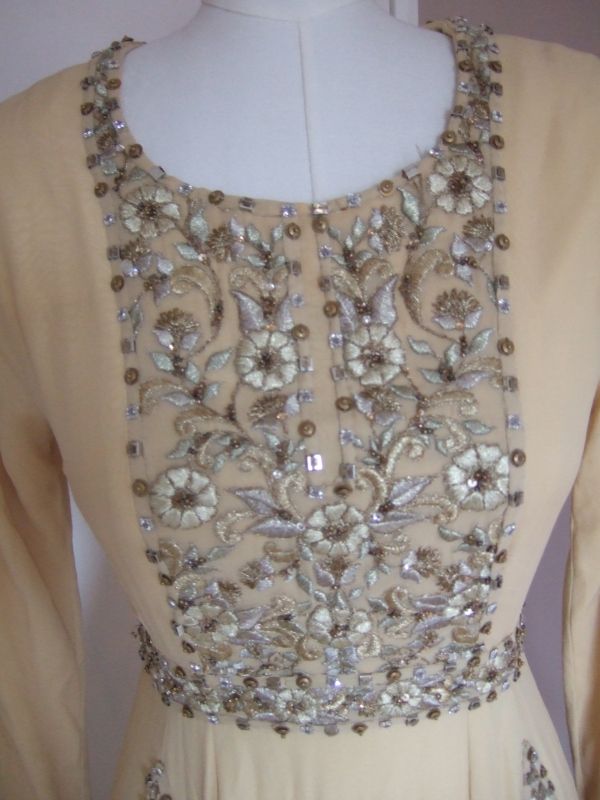
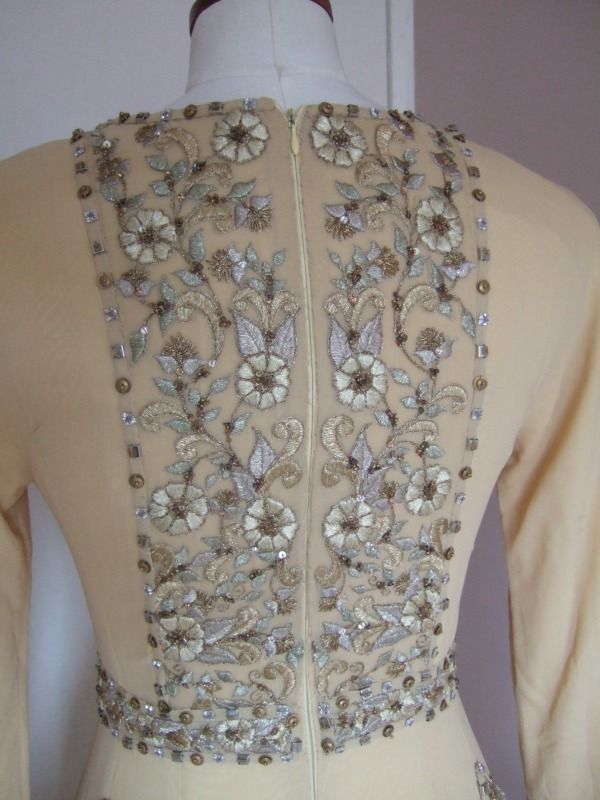
Apologies this is also out of focus, I was trying to show the sleeve construction, which is made in three pieces, two L shapes seamed down the top length of the arm, and a piece under the arm forming a section of the bodice.
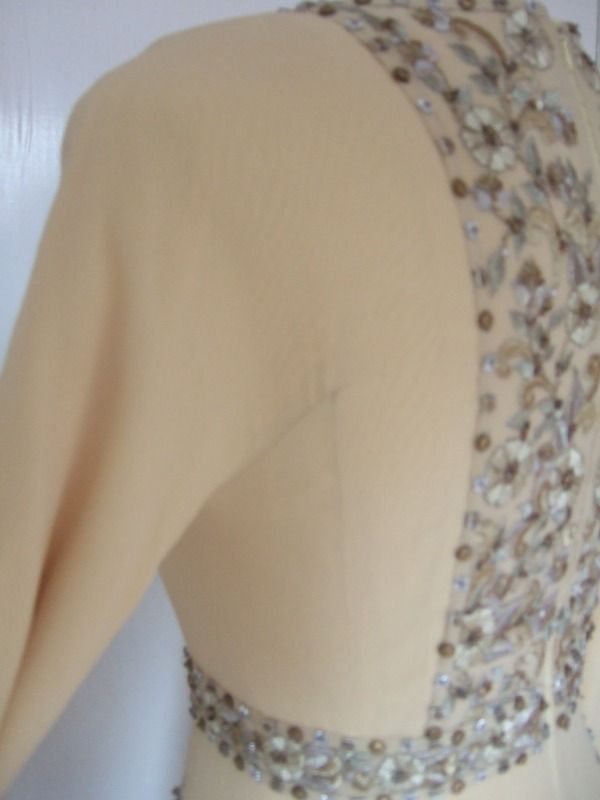
side view of the skirt godets:
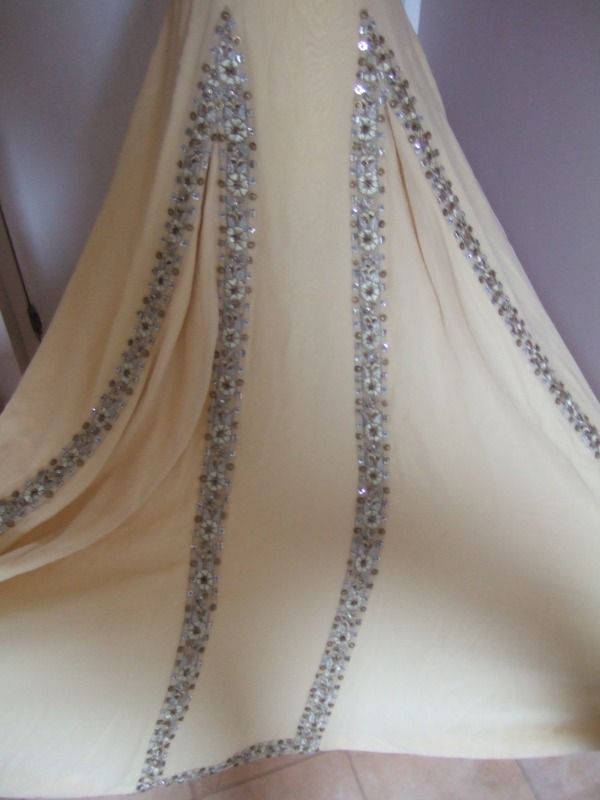
The embroidered monogram is backed on a different sort of sheer fabric, akin to the one used on dancewear I think for semi transparancy, the zip manufacturer is FFF? in a triangle. Note the unusual metal studs, shaped like giant staples? they are boxed and sit raised above the fabric.
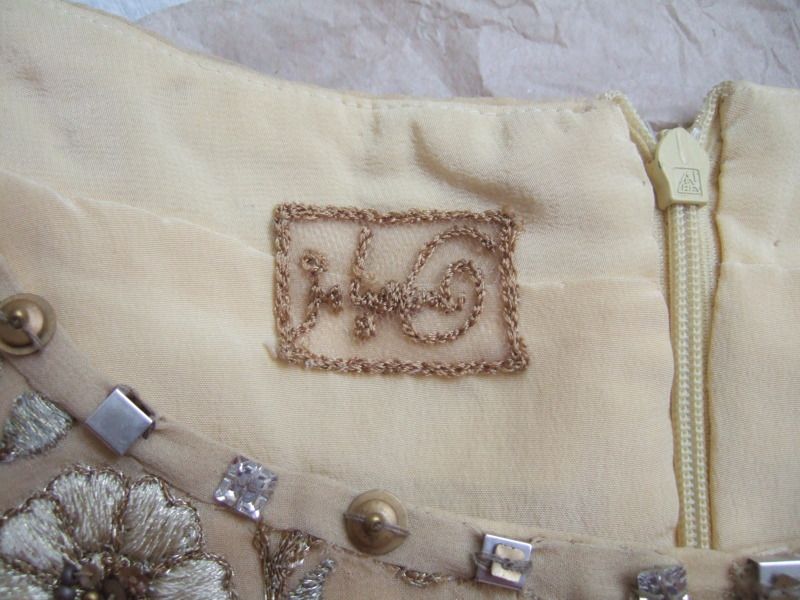
Some of the waist trim; showing hand sewing and the variety of beads/embellishments:
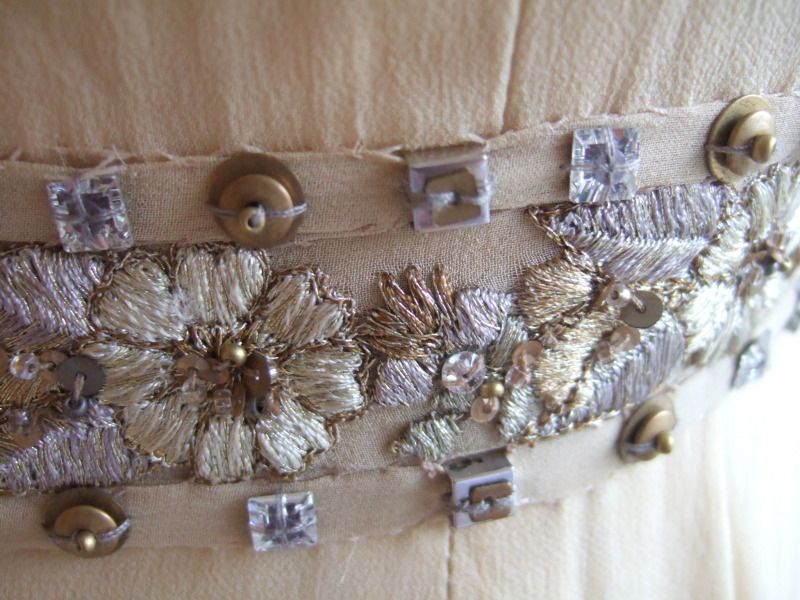
The small round pink beads on the left & right here made me wonder if those and the square diamantes are crystal - I used to work in a shop that sold swarovski embellishments and they distinctly remind me of them due to the subtle colour and reflective quality. I don't know if there is a way to check or not however.
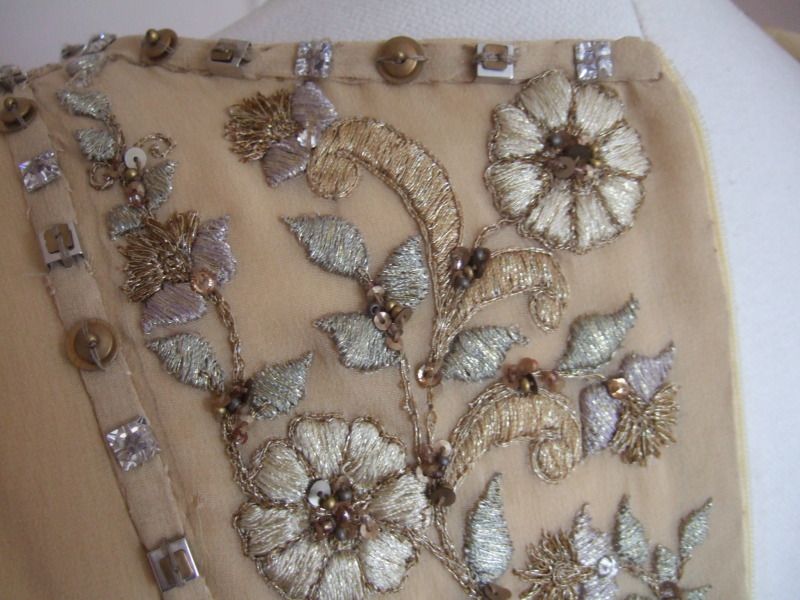
Cuff decoration with overlapping applique seam:
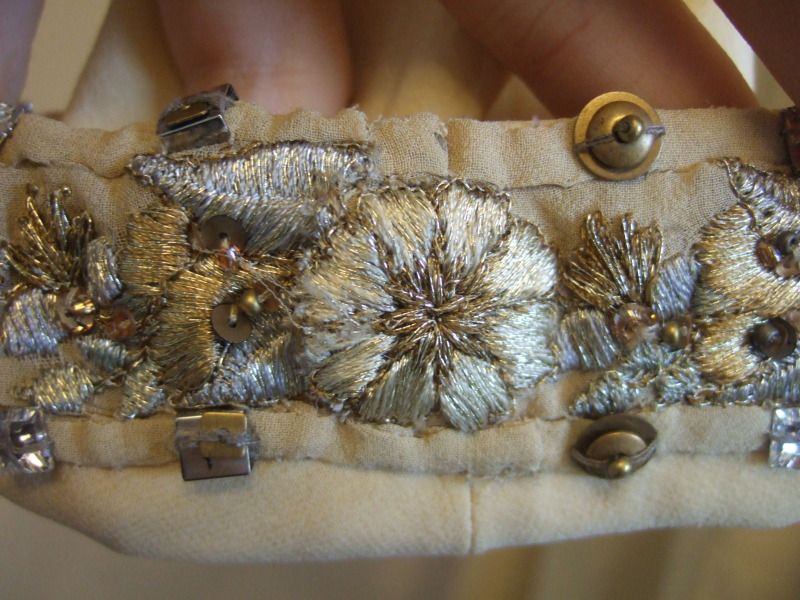
Inside out, for lining details:
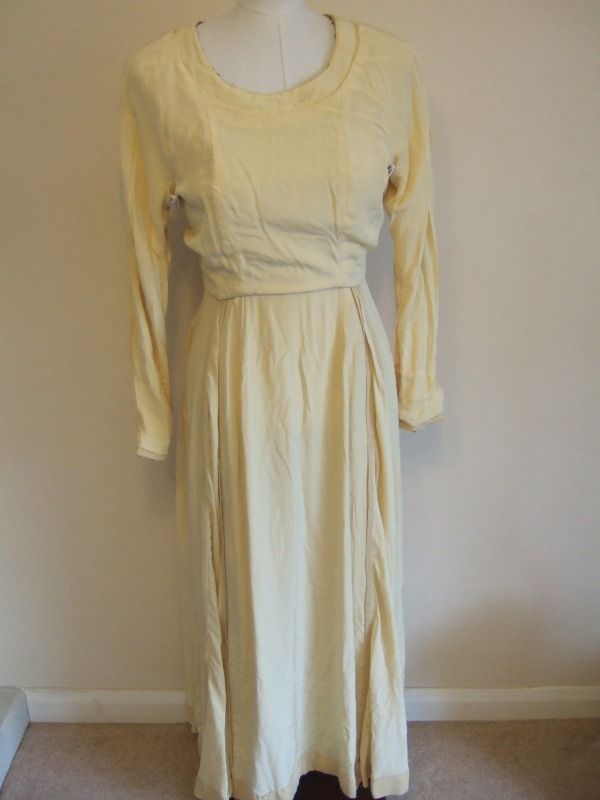
Inside neckline where bodice lining meets the front decoration backing; I'm not sure why these stitches are visible, considering they took such effort to hide all others, and yet this was clearly done before the lining was fixed in place.
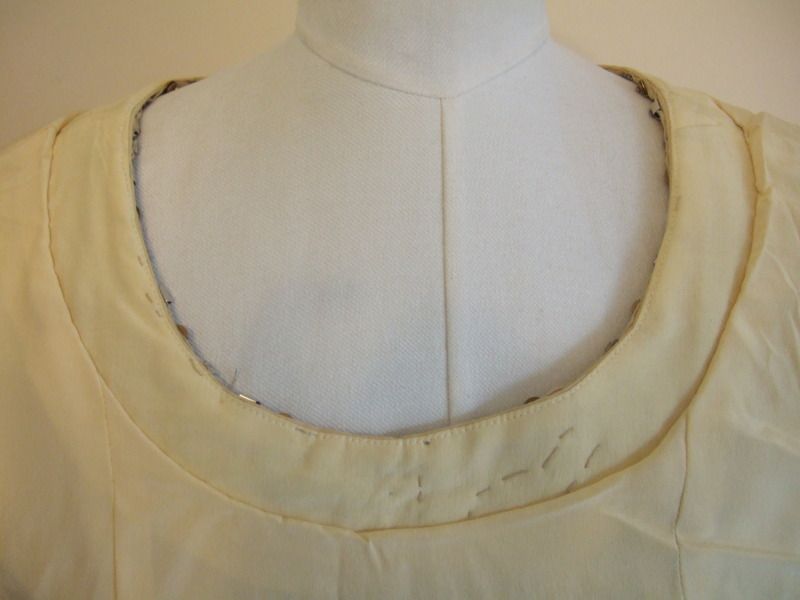
An impeccable sleeve! must also have been finished from the inside before turning the lining out and attaching the bodice,
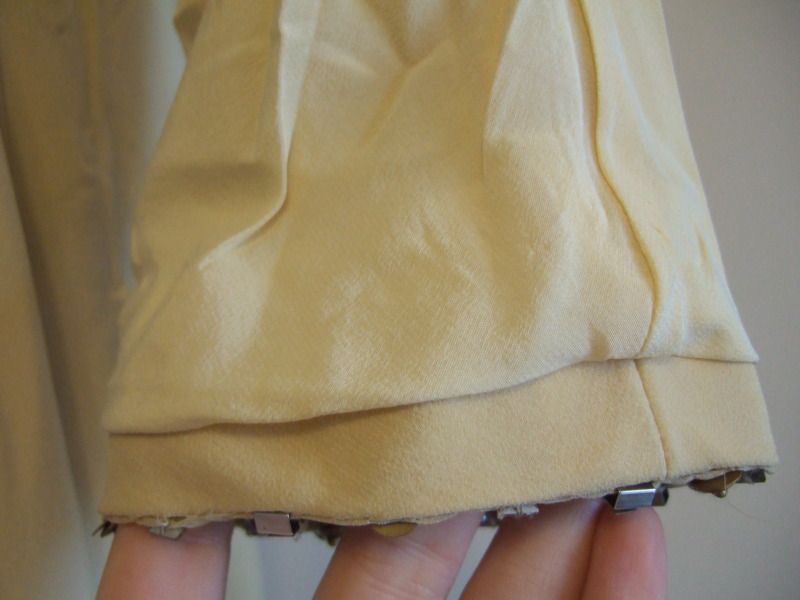
It has evidence of having been fitted: the pleat in the skirt waist seen on the left here has been taken in slightly as it has two rows of stitching whereas the right on has one, yet again this was done before the bodice lining was attached.
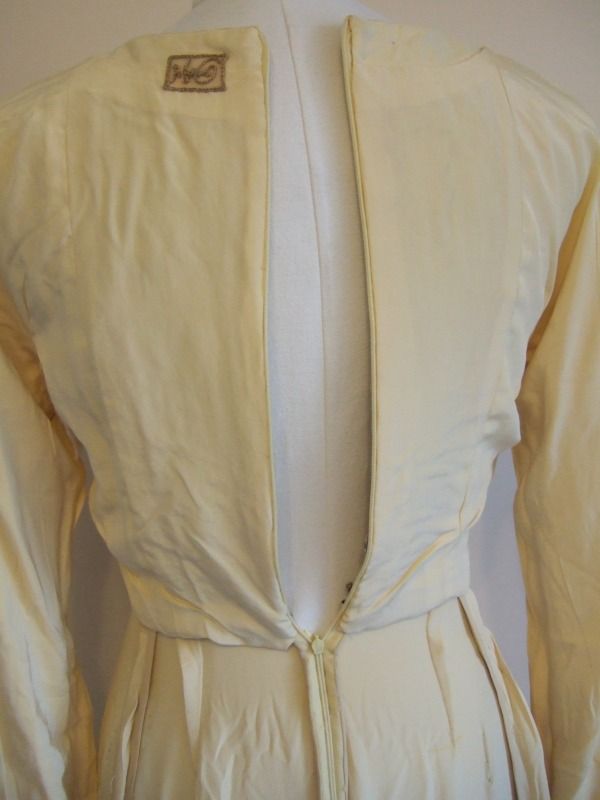
Closeup of the waist seam from the lining side, I can see three different threads here, and the remains of some tracing dots in yellow on the left:
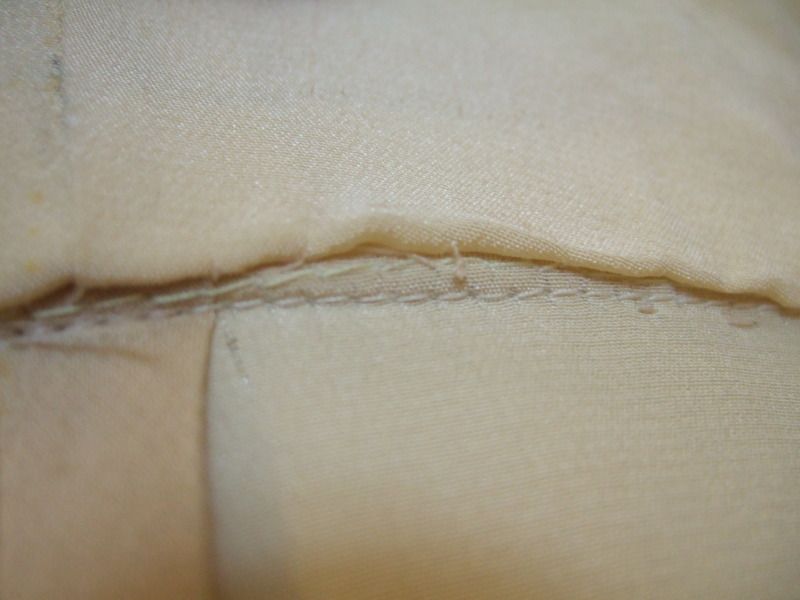
Inside finished zip: I don't even know how you get this result, I can only think the zip must be sewn into the lining first, and then the lining attached to the dress and handstiched to the dress outer.
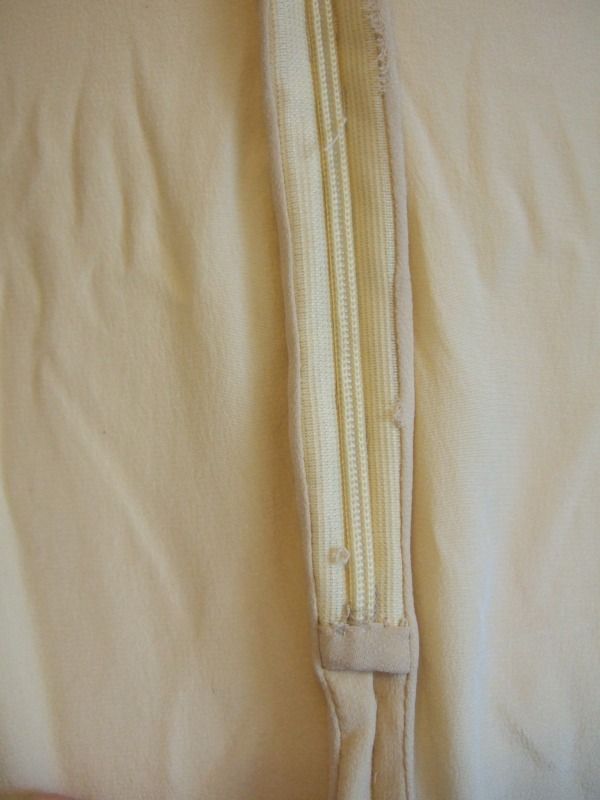
Top of godet insertion in lining: (the small stitches you can see are for the trim)
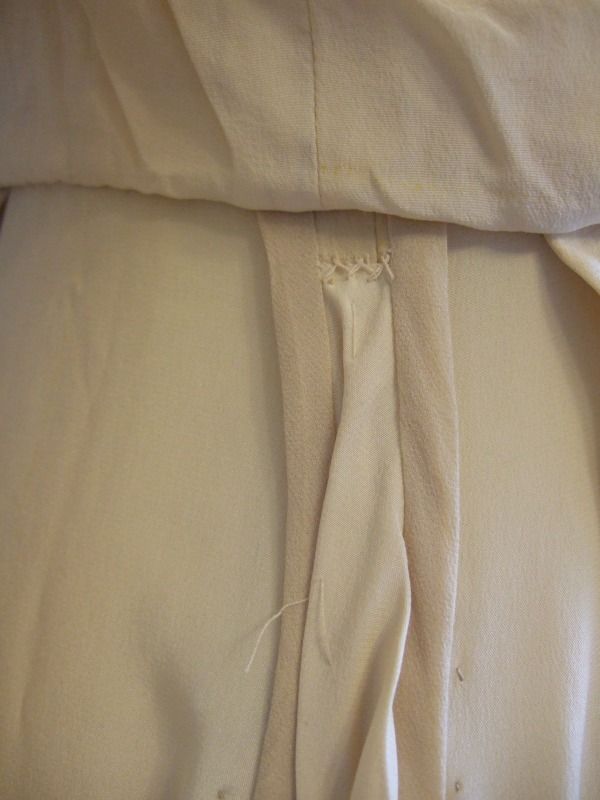
Skirt seam: I'm not sure whats going on here, it is either a regular or french seam, bound with same fabric as the dress outer, or it is actually the edge of the upper panel fabric that is taken in through the lining seam and wrapped around the lining seam to finish it.
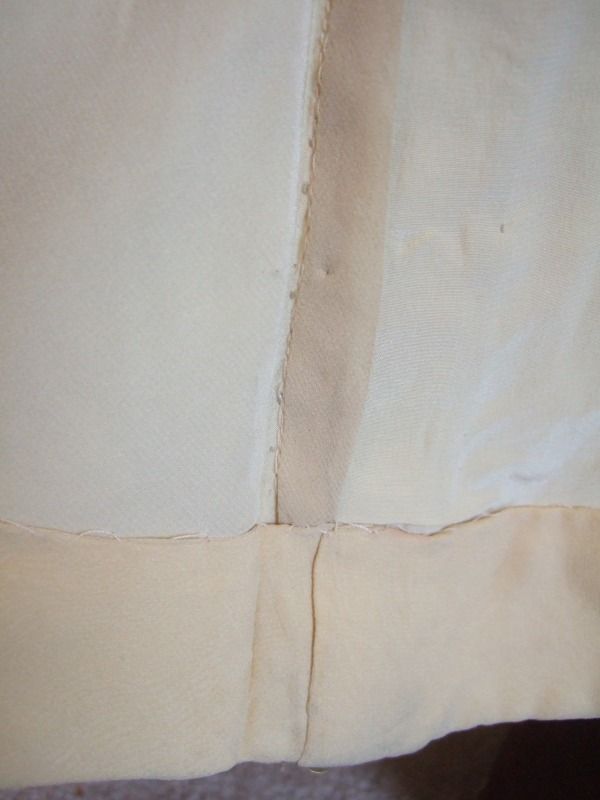
This would be one of the centre skirt seams, which is finished differently to the others, with a double? french seam
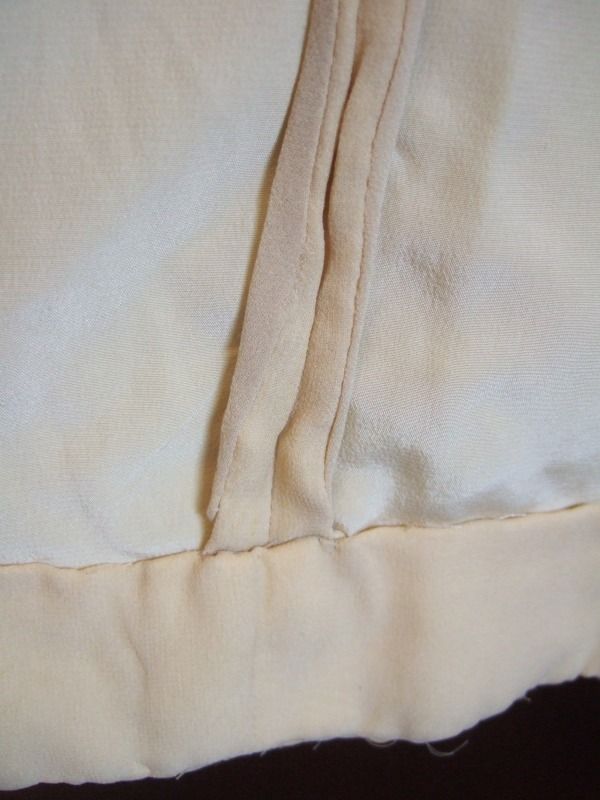




Apologies this is also out of focus, I was trying to show the sleeve construction, which is made in three pieces, two L shapes seamed down the top length of the arm, and a piece under the arm forming a section of the bodice.

side view of the skirt godets:

The embroidered monogram is backed on a different sort of sheer fabric, akin to the one used on dancewear I think for semi transparancy, the zip manufacturer is FFF? in a triangle. Note the unusual metal studs, shaped like giant staples? they are boxed and sit raised above the fabric.

Some of the waist trim; showing hand sewing and the variety of beads/embellishments:

The small round pink beads on the left & right here made me wonder if those and the square diamantes are crystal - I used to work in a shop that sold swarovski embellishments and they distinctly remind me of them due to the subtle colour and reflective quality. I don't know if there is a way to check or not however.

Cuff decoration with overlapping applique seam:

Inside out, for lining details:

Inside neckline where bodice lining meets the front decoration backing; I'm not sure why these stitches are visible, considering they took such effort to hide all others, and yet this was clearly done before the lining was fixed in place.

An impeccable sleeve! must also have been finished from the inside before turning the lining out and attaching the bodice,

It has evidence of having been fitted: the pleat in the skirt waist seen on the left here has been taken in slightly as it has two rows of stitching whereas the right on has one, yet again this was done before the bodice lining was attached.

Closeup of the waist seam from the lining side, I can see three different threads here, and the remains of some tracing dots in yellow on the left:

Inside finished zip: I don't even know how you get this result, I can only think the zip must be sewn into the lining first, and then the lining attached to the dress and handstiched to the dress outer.

Top of godet insertion in lining: (the small stitches you can see are for the trim)

Skirt seam: I'm not sure whats going on here, it is either a regular or french seam, bound with same fabric as the dress outer, or it is actually the edge of the upper panel fabric that is taken in through the lining seam and wrapped around the lining seam to finish it.

This would be one of the centre skirt seams, which is finished differently to the others, with a double? french seam

Vintagiality
VFG Treasurer
This may be totally silly of me but there is a Pakistani designer boutique called H G Fashions and they have some very ornate gowns. Here is an example:
http://www.apnadress.com/fashion/6676/Bridal-1
Victoria
http://www.apnadress.com/fashion/6676/Bridal-1
Victoria
Pinkcoke
Alumni
Thanks, that doesn't look a silly suggestion at all, at least in that this could be an Indian bridal gown, there is a 'Lehengas' here that has a similar front: http://www.apnadress.com/fashion/9142/sj2
That would explain the level of detail with modern construction. I could take this to little India and ask some of the boutiques there.
That would explain the level of detail with modern construction. I could take this to little India and ask some of the boutiques there.
